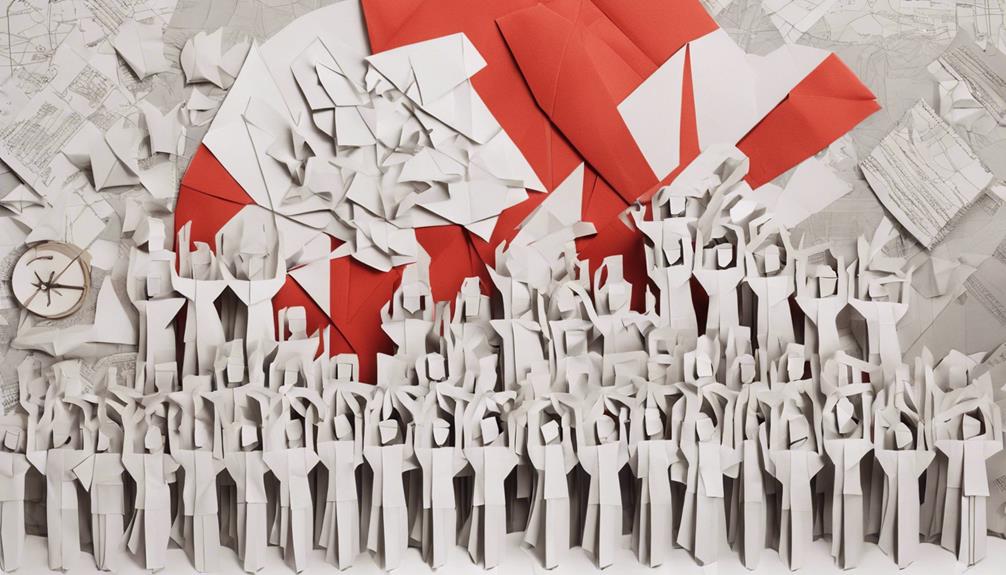Throughout history, protesting has proven to be a powerful tool in driving societal change and holding people accountable. Global demonstrations, such as the large protests against the Iraq War in 2003, have shown the significant impact of collective action. These protests not only raised awareness but also influenced political discussions on a global scale. The effectiveness of protests in shaping policies and inspiring social changes can be seen in various movements, like the Civil Rights Movement in the US and the ongoing advocacy of the Black Lives Matter movement. The incredible reality is that protesting can truly lead to meaningful outcomes, shaping the direction of societies.
Key Takeaways
- Protests have historical impacts, shaping discourse.
- Effectiveness varies based on public opinion influence.
- Sustained protests drive lasting societal change.
- Critiques challenge traditional methods, urging evolution.
- Strategic planning and adaptability enhance protest impacts.
Historical Impact of Protests
Examining the historical impact of protests reveals their significant role in shaping societal changes. The protests against the Iraq War in 2003 stand out as a prime example. Millions of people worldwide took to the streets to voice their opposition to the conflict, showcasing the widespread disapproval of the military intervention.
These demonstrations not only brought attention to the devastating consequences of war but also sparked debates on the legitimacy of the invasion and occupation. The sheer scale of these protests demonstrated the power of collective action in influencing public opinion and government policies.
The anti-war movement that emerged from these protests continued to be a vocal force in shaping political discourse and decision-making processes. The Iraq War protests serve as a poignant reminder of how public dissent can drive change and hold leaders accountable for their actions.
Effectiveness of Modern Protests

Modern protests have sparked debates regarding their effectiveness in driving significant societal change. The impact of protests on public opinion, the influence on policy changes, and the resulting long-term outcomes are key points of contention.
As discussions continue on the role of modern protests in shaping our world, exploring these aspects provides valuable insights into the efficacy of contemporary activism.
Impact of Protests
Recent global protests have raised concerns about their impact and effectiveness in bringing about lasting change. The focus on the scale rather than the purpose of public protests has been a significant factor in hindering their influence on policy and societal transformation.
This shift in prioritization has led to a lack of trust in traditional radical hierarchy structures, further impeding progress and sustainability in contemporary protests. Despite the massive participation seen in recent public protests worldwide, many countries have experienced minimal progress, and in some cases, even regression post-protests.
It's essential for activists to acknowledge the limitations of recent mass protests to reassess strategies effectively and work towards achieving meaningful change in the future. Understanding these challenges can help pave the way for more impactful and enduring outcomes from public protest movements worldwide.
Public Opinion Influence
With the ability to shape narratives and raise awareness about social issues, modern protests have demonstrated a significant influence on public opinion. The power of protest lies in its capacity to sway public sentiment and garner support for causes that demand attention. Through public demonstrations, rallies, and online campaigns, protesters can effectively communicate their grievances, sparking discussions and debates that resonate with wider audiences. This influence on public opinion can lead to increased pressure on governments and institutions to address the concerns raised and implement meaningful changes. Social media plays a pivotal role in amplifying the impact of modern protests, enabling information to spread rapidly and mobilizing individuals for collective action. The evolving landscape of public attitudes, shaped by the voices of protesters, has the potential to drive shifts in policies, laws, and societal norms over time. The power of protest lies not just in the visible demonstrations but in the lasting impact it can have on shaping the political and social discourse.
| Power of Protest | Influence on Public Opinion | Mobilization through Social Media |
|---|---|---|
| Shapes narratives and raises awareness | Sparks discussions and debates | Amplifies impact and reaches wider audiences |
Policy Changes Result
Despite the massive participation in recent mass protests, significant policy changes have proven to be elusive, raising concerns about the effectiveness of modern protest movements in achieving tangible outcomes.
While protests have historically been a tool for social change, the current landscape presents challenges that impact the ability of protests to translate into concrete policy alterations. According to Bevins, the emphasis on scale rather than purpose in modern movements can dilute the impact of protests, making it harder for specific policy changes to materialize.
Additionally, the presence of hierarchical structures within protest organizations has led to a lack of trust and coordination, hindering the effectiveness of protests in influencing policy decisions. As a result, many recent global protests have struggled to enact substantial systemic or structural changes in government policies.
The limited success in achieving significant policy changes post-protests prompts a critical examination of whether modern protests are effectively translating activism into actionable outcomes.
Critiques of Traditional Protest Methods

Critiquing traditional protest methods can lead to valuable insights on their effectiveness in driving societal change. Authors Nick Srnicek and Alex Williams, in their book, question the impact of protests like Occupy Wall Street on achieving substantial societal transformations. They argue that protests can sometimes devolve into mere spectacles, overshadowing the core issues they aim to address.
The media's tendency to sensationalize property destruction during protests further muddles the message and deters from the intended cause. Critics also highlight that traditional protest approaches risk becoming outdated, with lingering skepticism about their ability to bring about lasting societal improvements.
The challenge lies in modernizing protest strategies to align with current realities and overcome the criticisms of stagnation. As Srnicek and Williams suggest, traditional protests might need a revamp to truly serve as effective catalysts for meaningful societal change.
Power of Sustained Protest Efforts

Sustained protest efforts have historically demonstrated significant impact in driving societal change, as exemplified by the Civil Rights Movement in the US. The success of the Civil Rights Movement, characterized by the fight against segregation and discrimination, showcases the transformative power of persistent collective action.
The movement's piece-by-piece progress in challenging circumstances underscored the efficacy of sustained protests, leading to lasting societal change. The Civil Rights Movement's legacy continues to inspire new generations of activists, emphasizing the enduring impact of prolonged protest efforts.
More recently, the Black Lives Matter movement has further highlighted the power of sustained protests in advocating for racial justice and police reform. Through ongoing demonstrations and advocacy work, Black Lives Matter has brought issues of systemic racism and police brutality to the forefront of public discourse, prompting conversations and reforms at local, state, and national levels.
The sustained efforts of activists involved in the Black Lives Matter movement exemplify how continuous protest actions can drive meaningful societal change and promote social justice.
Evolution of Activism

Activism in modern times has shifted towards more nimble, participant-driven strategies and away from mass-led approaches, emphasizing adaptability and decentralized leadership structures. Movements now focus on tactics rather than sheer numbers, ensuring agility and guarding against autocracy in protest leadership. Prefigurative politics and tactical activism have gained prominence, emphasizing local ambitions and societal norm shifts.
| Evolution of Activism | |||
|---|---|---|---|
| Key Point | Description | Example | Impact |
| Participant-driven | Emphasis on individuals driving change rather than mass participation | Tahrir Square protests in Egypt | Increased adaptability |
| Decentralized leadership | Shift towards leadership structures distributed among participants | Occupy Wall Street movement | Enhanced inclusivity |
| Tactical activism | Focus on specific actions to achieve goals rather than broad strategies | Black Lives Matter protests | Targeted impact on policy change |
This evolution has led to more dynamic and responsive movements, capable of addressing specific issues with precision and adaptability.
Strategic Vision in Social Movements

Developing a clear strategic vision is essential for the success of social movements. This involves meticulous planning, from overarching goals down to specific tactics. Successful protests hinge on detailed organization, including the selection of effective leaders and communication strategies.
Historical movements such as the Montgomery bus boycott exemplify how weeks of planning and precise execution can lead to success. Paying attention to details, such as the quality of audio equipment during events like the March on Washington, can elevate protests to national significance. When protests are performed with a strategic vision in mind, they hold the potential to effectively alter the course of national history.
In today's landscape, social media plays a critical role in shaping and disseminating this strategic vision, allowing movements to reach wider audiences and mobilize support more efficiently. Incorporating social media into the strategic planning of social movements has become increasingly important for their success.
Organizational Structures in Protests

In successful protests, protester unity strategies, defined leadership roles, and effective decision-making processes play vital roles in achieving objectives. These organizational structures provide a framework for clear communication and coordinated action, ultimately enhancing the impact of the protest movement.
As seen in historical examples like the civil rights movement, having well-defined organizational structures can contribute greatly to the success and longevity of protests.
Protester Unity Strategies
Spontaneous tactical assemblies and minimal involvement of preexisting organizations characterize the organizational structures in digital-age protests. Through the power of social media, adhocracy enables individuals to swiftly mobilize crowds for demonstrations. However, this approach presents challenges, such as the difficulty in coordinating shifts in tactics and maneuvering complex negotiations due to the absence of clear organizational hierarchies.
Contrasting the current landscape with historical movements like the postwar civil-rights protests reveals the benefits of established structures. These structures facilitated effective communication and coordination, enhancing the impact of the protests. Successful protests often involve careful planning, a strategic vision, and meticulous attention to detail. These elements elevate protests into national dramas that can alter the course of history.
In the field of protester unity strategies, the evolution towards digital-age organizing brings both opportunities and obstacles. Balancing the spontaneity of adhocracy with the advantages of structured organizations remains an important aspect in maximizing the effectiveness of contemporary protests.
Leadership Roles Defined
When examining leadership roles in protests, it becomes evident that decentralized structures often place emphasis on movement masses for strategic direction while leadership focuses on tactical implementation. In digital-age protests, adhocracy is commonly utilized, characterized by spontaneous organization and minimal involvement of traditional entities. This decentralized approach can complicate negotiations with authorities and lead to ambiguity in representing protesters. Contrasting this, historical movements like the civil-rights protests postwar era had well-defined organizational structures that facilitated effective communication and coordination. Successful protests often require meticulous planning, a clear strategic vision, and meticulous attention to detail, transforming demonstrations into impactful national spectacles.
| Leadership Roles in Protests | Description | Example |
|---|---|---|
| Movement Masses | Emphasizes strategic direction | Occupy Wall Street Movement |
| Tactical Leadership | Focuses on implementation of strategies | Black Lives Matter Protests |
| Adhocracy | Spontaneous, minimal traditional involvement | Extinction Rebellion Protests |
Decision-Making Processes Utilized
Utilizing defined organizational structures in protests enhances decision-making processes by fostering clear communication, coordination, and strategic effectiveness. In the digital age, protests often rely on adhocracy, characterized by spontaneous organization through social media with minimal involvement from established groups. While this style allows for swift mobilization, it can present challenges in coordinating tactics and negotiating due to the absence of a clear organizational structure.
Contrastingly, successful historical protests, such as the Montgomery bus boycott, involved weeks of meticulous planning, focal point selection, and extensive distribution networks. Organizational structures play a pivotal role in enhancing communication, coordination, and effectiveness within protests. The postwar civil rights movement exemplifies this through its abundant structures, which facilitated strategic decision-making and impactful outcomes.
Strategic vision and attention to detail, such as ensuring the audibility of speeches, can transform protests into national spectacles with profound historical repercussions. By embracing structured organizational frameworks, protesters can elevate their movements and increase the likelihood of achieving their desired goals.
Adaptability in Protest Movements

How important is adaptability for protest movements to effectively achieve their objectives?
Adaptability plays a vital role in the success of protest movements by enabling them to respond to changing circumstances and optimize their impact.
Here are three key reasons why adaptability is essential for protest movements:
- Utilizing Smartphones and Social Media:
Adaptable movements leverage technology to mobilize supporters, coordinate actions, and disseminate information rapidly.
- Reacting to Unforeseen Challenges:
The ability to adjust strategies in real-time allows protest movements to overcome unexpected obstacles and maintain momentum.
- Seizing Emerging Opportunities:
Adaptable movements can capitalize on new developments, such as shifting public opinion or governmental responses, to advance their cause effectively.
Impact of Digital-Age Protests

Adapting to the digital age has revolutionized the impact of protests, with faster responsiveness and increased mobilization capabilities through social media and spontaneous tactical assemblies. In places like Hong Kong, digital-age protests have showcased the power of online platforms in organizing large-scale demonstrations swiftly and efficiently. These movements often see a minimal involvement of traditional organizations, relying instead on adhocracy for quick decision-making and coordination.
Social media plays a pivotal role in enabling individuals to gather crowds rapidly for protests, leading to swift mobilization and heightened visibility of the cause. However, challenges do arise in digital-age protests, such as difficulties in shifting tactics promptly, complex negotiations due to a lack of clear representation, and the organizational toothlessness that can hinder sustained impact.
Despite these challenges, historical protests like the Montgomery bus boycott serve as a reminder of the importance of careful planning, strategic vision, and structured communication for successful outcomes in the digital age.
Frequently Asked Questions
Is Protest Positive or Negative?
Protesting can be both positive and negative. It raises awareness and inspires change, but can also lead to disruptions and clashes. The outcome depends on factors like public support and government response.
Why Is Protesting a Right?
Protesting is a right because it empowers you to challenge injustices, demand accountability, and shape a better society. By peacefully assembling and voicing dissent, you contribute to the democratic process and drive change.
Is There Such a Thing as a Peaceful Protest?
Yes, there is such a thing as a peaceful protest. Expressing dissent peacefully can amplify voices, raise awareness, and pressure authorities. While not always leading to immediate change, peaceful protests are a fundamental democratic tool.
What Are the Negative Effects of Community Protests?
When community protests erupt, like a storm over a quiet town, businesses suffer, relations strain, resources redirect, reputations tarnish, and support wanes. The consequences are real, painting a challenging picture for all involved.
Can Embracing Negative Emotions Lead to More Successful Protests?
Embracing negative emotions can transform your life with negative emotion. While protest movements often focus on positivity, acknowledging and addressing negative feelings can lead to more successful outcomes. By harnessing anger, frustration, and passion, protestors can drive meaningful change and empower others to join their cause.
Conclusion
To sum up, protesting has been a powerful tool throughout history, with varying levels of effectiveness. While traditional methods may face critiques, sustained efforts and adaptability have proven to make a significant impact.
The evolution of activism, strategic vision, and organizational structures in protests have all contributed to the success of social movements. In today's digital age, protests continue to be a crucial means of driving change and shaping a better future for generations to come.










